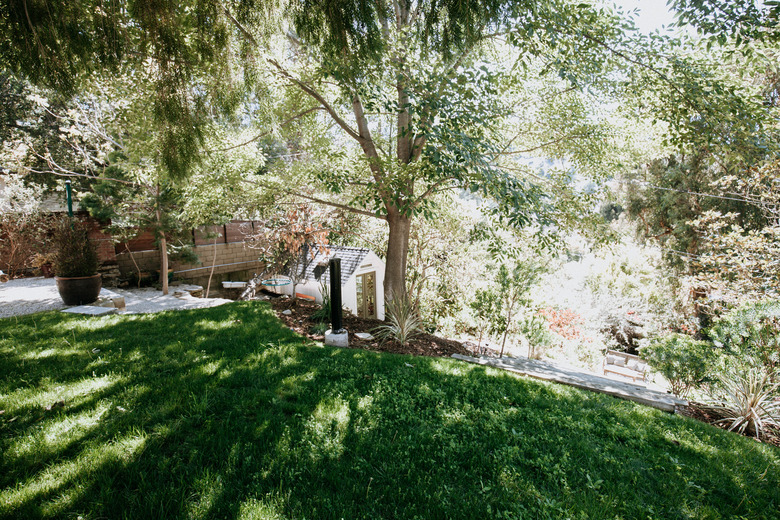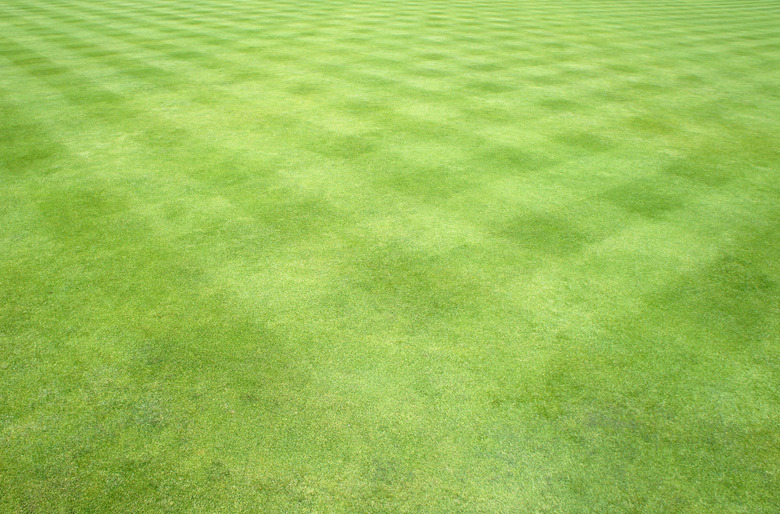The 3 Best Mowing Patterns (And How To Make Them)
If you've ever been to a baseball park, you've probably wondered if you could make one of those intricate mowing patterns in the outfield with your own mower at home. The answer is yes — you can. It doesn't take a special mower or even professional equipment to create a mowing pattern in your lawn.
Here are the three best mowing patterns — as well as tips and tricks to get the best lawn on the block.
1. Stripes and Wave Patterns
Creating a basic striped lawn is the easiest mowing pattern because it's how most people mow their lawn on a regular basis — just mow in one direction, turn around and come back in the other direction. There are a couple of tricks to make your stripes look their best. Begin by mowing the edges of the lawn for a strong, uniform border. Mowing the first stripe in a straight line will help keep the rest of the stripes straight as well. Use Y turns at the end of each row by angling the mower at 45 degrees toward the previously cut stripe and then backing up the mower in a U shape to the edge of the next uncut row to avoid sharp or curved turns, which can ruin the pattern.
Waves are a great way to add a little creativity and flair to the basic striped lawn mowing pattern. You will mow in one direction in a soft, curving pattern, keeping the waves consistent. Go back and forth like you would for a striped lawn, keeping each pass consistent with the pattern of the first wave. You can get creative and make your waves longer or tighter depending on the size of your lawn and how you want it to look.
2. Checkerboard or Diamond Pattern
A checkerboard pattern is a great way to make your lawn stand out, but it can be time-consuming because you are essentially mowing your lawn twice. Start as you would to mow a basic striped pattern, mowing back and forth lengthwise in a series of straight rows. An alternative to using a Y turn at the end of rows is to lift the mower deck before you turn to start a new row. Then, mow a series of stripes widthwise, perpendicular to the first rows. For a neat, uniform border, mow straight lines around the perimeter.
Making a diamond mowing pattern is very similar to the way a checkerboard pattern is created. You mow a set of stripes and then another one in the opposite direction of the first. The difference is that you don't mow lengthwise and widthwise but instead mow diagonally across the lawn. For a diamond pattern, it is easier to start mowing a straight line in the middle of the yard and then do a return pass next to it and so on. As with the checkerboard pattern, you can finish with a pass around the perimeter for a neat border.
3. Circular Mower Pattern
Using your mower to make a circular pattern in your grass is a fun way to create a standout lawn while mowing around trees, shrubs, flag poles, and other landmarks, but circular mowing patterns can also be done without these landmarks. Start by mowing a circle around your tree or flagpole, which will be the center of your circle. If there is no tree or flagpole, start by mowing a circle in the middle of your yard.
It's best to keep the first circle as small as possible. After mowing the first circle, mow a circle in the opposite direction. The circles will become increasingly larger as you mow in alternating directions. Because it is often difficult to complete a large circle around the edges of a yard, you can tidy it by mowing a straight stripe around the perimeter of the property.
How Mowing Patterns Are Created
For many people, the idea of creating a lawn pattern seems out of reach for the average homeowner, like a twilight league baseball player making the major league, but anyone with a lawn mower can create a pattern in a lawn because the stripes or patterns in a lawn are just light reflecting off bent blades of grass. Grass blades bent toward you appear darker, while grass that is bent away from you looks lighter. Because of this, the light and dark stripes will change depending on the angle from which you are viewing the lawn.
To really make mowing patterns stand out, you'll want to purchase a lawn striping kit (like this one from Toro) for your mower. A lawn striping kit is basically a light roller that fits on the back of your mower and flattens the grass blades as it rolls over them. Striping kits are available for use with both push and riding mowers, so you should be able to find one that fits your mower.
If you don't want to purchase a striping kit, here's how to get the mowing patterns:
- Mow your lawn normally.
- Turn off the mower.
- Lower the deck and go over it again (without the mower running) to allow the lowered deck to flatten the grass.
This is a time-consuming but less expensive way to intensify your mowing patterns.
Mowing Pattern Tips
There are many different mowing patterns from which you can choose to decorate your lawn. Following a few helpful tips will help you keep your lawn healthy and looking its best no matter which pattern you decide to use.
- Proper mowing is important for a healthy lawn, which in turn is key to making your designs stand out.
- Do your mowing in the early morning or in the evening. Your grass can be severely damaged by mowing in the heat of the midday sun.
- Keep your grass a little longer. This will help strengthen the roots while emphasizing your lawn pattern by allowing the grass blades to bend more. A good rule of thumb for vivid mowing patterns is to keep your grass between 3 inches and 3 1/2 inches long.
- Use the 1/3 rule: Only cut the top third of the grass.
- Keep the blades of your mower sharp. This will ensure a straight, even cut that will keep your lawn healthy and make your mowing patterns stand out.
- Mow the lawn when it is dry. This will improve your mower's performance and keep the grass from being matted down.
- Change your mowing pattern every couple of weeks to keep your lawn healthier by allowing the grass blades to bend slightly in different directions.
When it comes to mowing straight lines, self-propelled and riding mowers are better because they take a little bit of the human element out of it and are designed to go straight. You can mow a straight line without a self-propelled mower by focusing on a spot 10 feet ahead instead of watching the ground in front of the mower or by setting up a marker for yourself.


